If you're new here, you may want to subscribe to my RSS feed. Thanks for visiting!
Over the past few months, my husband and I have kept an eye on the store shelves in our area. We don’t shop daily or even weekly, but the trend of increasingly bare shelves has been incredibly disturbing. This made me curious as to what others have been experiencing. As a member of various online prepping communities, I see a lot of conversations and concerns, but one thing that has stood out to me is the amazing number of people chiming in to report sparse or bare shelves or just not being able to find a specific item they like.
We visited many different stores.
Over several months we visited various regional and national grocery stores, drug stores, and dollar store chains.
You may be able to guess where these pictures come from but I am not going to mention store names because I fear that by doing so I will contribute to a damaged reputation for these stores. I don’t want to affect the financial well being of the hardworking families that rely on their employment with these stores.
The main grocery warehouse for a major regional chain is quite close, and they are a well-capitalized company with no significant financial difficulties, but even they seemed to have problems keeping some items on the shelf.
Here are the most commonly out of stock or in short supply items.
The pictures in this article were not taken during snowstorms. They were taken during a typical shopping day in the winter time in the USA. My husband and I wanted to make sure that snow was not making the results worse than they actually are. This research is intended to inform, not foster unwarranted fears.
Please excuse the blurry quality of some images, we were moving fast and also trying not to be too obvious when exploring stores.
Trash bags of all sizes. Store brands of trash bags were missing, or in short supply, at all the stores we visited over the past few months.
Convenience and canned goods
Non-rechargeable batteries. AA and AAA sizes were the ones missing most often
Large packs of toilet paper and paper towels
Larger bags of pet foods and some canned varieties
Frozen foods
Canned meats
Storage totes and plastic food storage containers
Toothpaste
Over the counter pain relievers and antacids
Other items that were regularly missing:
- 5 and 10 lb bags of rice
- Large canisters of oatmeal
- Cosmetics
- Light bulbs
- Basic hardware items
- Outdoor gear
A lot of people think bare shelves are the result of food stamp benefits being issued early.
Food stamps being issued early had only a slight effect on store stock, but it was more noticeable in some areas due to stock already being low.
Food stamps were issued early, with many people receiving their February benefits by January 20th on average.
While this did lead to some people buying more groceries and supplies during January, this would only explain some of the low inventory that happened within the last few weeks, not the low stock that we have seen over the course of many months.
Excuses are rampant when it comes to bare shelves.
I have tried to listen in on workers when I am out shopping. It is not too hard to do because they talk among themselves when stocking and it is impossible not to catch a few things.
“We have not had that in weeks.”
“We have not got that in forever. Not sure if we ever will.”
Someone very close to me also works at a major box store retailer, and when comparing statements, it is incredible how close the stories of workers match no matter what part of the country they are in.
Here are the most common stories workers are being told:
- The trucks are late.
- Our store was not designed for the number of shoppers that we have now. Business is so good we cannot keep up supply.
And here’s the problem with those stories.
It is not profitable for stores to be understocked. If they are turning customers away due to not having items, then they are losing money. If business is that good, then it would make sense for their corporate headquarters or distribution people to make sure that more trucks are sent so they can sell more and have a more profitable store. Empty space and turning people away costs money. Why on earth would any business keep a store understocked and not able to meet demand unless there was an excellent reason that is beyond their control?
I have spoken to various people that work in retail. I have omitted names to protect the privacy of those that were kind enough to share their experiences with me so I could bring this information to you so you may be better prepared for items being short.
Here’s what a long time hourly worker at a major big box store had to say:
“I’ve worked all over in the store. Things have been weird the last two years here. We are carrying much more prep related items. Freeze dried food, 20lb bags of rice and flour, 25lb bags of sugar, bulk displays of peanut butter and canned chicken, big displays of canning jars, lids and five-gallon pails. The store never carried these items five years ago.
We even remodeled the store to accommodate these large bags etc.
Produce has been bad in the last year.
The home office is consistently trying to find new suppliers for produce. I’ve seen the emails myself.
We are out of many items that I feel we shouldn’t be. Pasta is one; we are constantly running out of pasta. This makes me think there are some shortages of semolina wheat, but I have no proof.
We are always just on the verge of running out of canned goods and other grocery items. If we didn’t get trucks six days a week, the store would be out in 48 hours. Things like toilet paper also run very low. There have been several RX’s that I couldn’t even get refilled. Ciprofloxacin, Prednisone, and Losartan to be exact. I hear customers complaining that they have to wait a couple days for their RX’s to come in. So yes I believe something is up, but that’s all I know. I hope this info helps you.”
According to my source, it is challenging to keep pasta in stock.
A regional box store chain worker in Washington State said:
“There are empty spaces because we run out before shipment comes in. Especially days where certain trucks don’t come. Our store just like any big box store faces zoning issues. Bringing things to the front to make it look nice and full. Rule of thumb has always been to pull at minimum two items forward. So if you have three facings of the same item, you will want to bring a total of 9-12 forward. It depends if they’re stacked. They want the shelves to look full and nice. I’ve been working retail for a while, and they always want this done in every store. At the end of my shifts at my store, they would have us zone if we had time. They would always say that if only one was pulled to the front as soon as someone grabbed that can, it would look empty again.”
Store employees are bearing the brunt of customer frustration.
Employees are taking abuse and harassment due to empty shelves. Customers direct their frustration at the most available target, the cashiers and stockers. They are never happy with the answer and get very frustrated if the employees have no information.
During my interviews and research, I have gathered that customers are constantly giving workers a hard time about there not being something on the shelf or asking if there are any on the back.
The thing that a lot of people are missing is that there is no “in the back.” Stores have very little storage if any in the back. Most of the time the back is just where things are loaded and unloaded and stored until they can be put out and that happens fast. This is not the old days where there were storage areas for lots of extra stock at smaller stores. Our goods are almost always in motion or on shelves. Storage costs money.
Part of the problem is the “warehouse on wheels business model.”
One reason we have been able to enjoy lower costs of goods over the years is due to products being always in motion and not setting in a warehouse that has a lot of upkeep costs. Real estate and storage are expensive, so if you can keep the goods flowing in trucks and not maintain a warehouse, big companies can afford to charge less and still make a profit.
Of course, the main problem with this model is that if the trucks stop moving or experience delays, there are supply disruptions. If there are not enough drivers, the situation can get bad enough that even if goods are setting in a container at one of the many ports in our nation, there is no one to get them where they need to go.
There are several possible causes of bare or scant shelves at stores.
There are many theories presented by various individuals regardless of political opinions. I am going to explore some of the more common ones and discuss.
Trucker shortages are causing problems.
A shortage of truck drivers is a common argument anytime there is an issue with store stocking or various supply issues. Yes, it is true that there is a problem finding enough truckers, but this alone is not enough to explain short shelves throughout the country.
According to a long haul trucker I interviewed that has been in the industry for 18 years and managed a fleet of 40 trucks, the shortage is real. Numbers are down over 100,000. After hearing first hand what drivers are facing, it is easy to understand the challenges the shipping industry is having.
Electronic logging regulations have crippled our nation’s shipping industry.
In the past truckers were allowed to keep their timesheets manually. Now government regulations require electronic monitoring to prevent drivers from driving too long and becoming a danger to themselves and everyone on the highways. To some, this may sound like a good idea, but on closer inspection, it is incredible how many problems it has caused
- Truckers are only allowed a 14 hour work day but only 11 hours can be spent behind the wheel.
- 14 hours sounds like a lot, but that is the time from clocking in to clocking out regardless of how many hours or miles are driven. So if you are stuck in traffic for 3 hours and only travel 20 miles in that time, and get paid by the mile, a large portion of your workday is gone, and you barely made anything during those 3 hours. There is not enough time to make it up. According to government rules you were on the road that whole 3 hours if setting in traffic so you can only drive 8 hours more during that day.
According to my sources, drivers were able to show “Sleeper” while waiting to load which would extend their workday; now once the clock starts, you have 14 hrs. To complete your day regardless of what happens during that 14 hrs. Many people cannot make a living this way.
Driver conditions are appalling.
Have you noticed more trucks just sitting on at on ramps? Some of this is because truckers must get off the road at the end of their 11 hour drive time or 14 hour work day, whichever comes first. This means they are stuck on the side of the road at an exit and possibly without services until they can legally clock back in. Even if they are 20 minutes away from a good and more comfortable place to safety stay, take a hot shower, get some hot food, they have to stop. This is easy to have happened no matter how good the driver is at planning.
This can lead to late deliveries of goods and makes it hard to plan supply chains.
Older drivers are retiring, and there is no incentive for younger people to replace them.
With little money to be made and unpleasant working conditions, no wonder no younger people want to pursue a career in truck driving. When you have a limited amount of hours that you can be on the clock and limited driving times and this is all related to conditions that are often beyond your control, and you are getting paid by the mile, you have no idea how much money you will have at the end of a pay period.
Driving a long haul truck requires training and licensing that disqualifies many people.
You don’t just go apply for a job being a truck driver and hit the road the next day. Here are the main requirements to legally drive a semi-truck.
- Obtain a commercial drivers license
- Attend a truck driving school
- Have a clean driving record and work history.
- Be at least 21 Years old
- Pass a drug and alcohol test
- Undergo a physical examination
Given that we live in a country with 70,000 drug overdoses a year and many of them being younger people, substance abuse and lack of physical fitness are enough to disqualify many from considering truck driving without making some major life changes.
Then there is the issue that some states have legalized marijuana but it will still disqualify someone from being able to obtain a CDL.
Another major deterrent is the cost of truck driving school. The average cost for a CDL is $3,000-$7,000. Some companies may offer reimbursement upon hire but it may not be given back to you all at once. Going into debt to be a trucker is not something some people could do even if they really wanted to.
Here’s what a typical day for a truck driver is like, post electronic regulations.
This information was given to me by someone that manages a fleet of 40 trucks:
- 5:00 am Start Truck and Do a Pre-Trip
- 5:45 am Drive to a Shipper (Big Box Store Distributor for example)
- 6:30 am Arrive and sign in at Shipper
- 11:00 am Pull to the staging area to load the truck
- 3:00 pm Get Loaded
- 3:30 pm Get Paperwork and leave the shipper.
- 4:30 -6:00 pm Sit in traffic trying to get to the open road
- 6:00 pm-7:00 pm Drive
- 7:00 – 7:30 pm: Post-trip inspection
Total miles traveled about 100 on an 800-mile trip before you have to stop and wait until you can legally work again.
8:00 Dispatch calls and wants to know why you didn’t make delivery AND the electronic logs have you shut down till the next day. This means the trip is going to take you another day.
When the pay is “by the mile” that driver made an average of $42 for that day while the pay for an 800-mile trip is $336 (company driver).
“A lot of drivers go to a fast food chain to make more money and be home without the headaches.”
That’s right folks, our nation’s truckers are better off with a fast food job with a guaranteed rate of pay than working at a job that pays by the mile.
The trade war with China is impacting supplies.
The recent trade war issues cannot help but affect the inexpensive Chinese goods we are used to. Many of the items that seem to be in low supply are those made in China. We may have to get used to not having access to cheap Chinese household supplies like trash bags and batteries.
As the situation continues, supplies could dip lower. There are a lot of containers setting in shipping yards with goods that have already come into the US. How these goods are distributed and who gets what can vary. Stores with significant purchasing power have their own supply networks and can decide how they want to distribute based on any factors they choose.
This means that if you are in an area that a company doesn’t see as a priority, your store may not get the truck delivery that everyone is hoping for.
There are just fewer grocery stores than before for many different reasons.
Over the years the small town and area we live in have seen a loss in grocery stores and variety stores that sell grocery and essential household items. Over the last 18 years, we have lost ⅓ of our grocery stores, pharmacies, and dollar style stores. There have been no replacements.
Other towns in our area have seen similar reductions in stores so I know that it is not just our town. Online shopping, thin margins, competition from other chains, and other factors have all played a role.
Poor and high crime areas get overlooked when new grocery stores are planned.
With margins being thin, it is not a massive surprise that companies carefully research demographics. While this may seem unfair and even racist to some, it is the reality we face.
When a more impoverished neighborhood loses a grocery store, it is often not replaced, thus creating a food desert within a city or community.
Grocery store chains also pick and choose where they open stores based on factors such as average income, traffic patterns, and crime rates. This means low-income areas or areas where grocery store chains suspect they may have higher than average shoplifting rate, get overlooked, and residents are left to find groceries at convenience stores or variety stores such as Dollar General. This limits access to fresh foods, leading to people eating a diet that is not good for their overall health and well-being. (Source: Charlotte Observer)
When fewer grocery stores are servicing the same population or an increasing one, this puts a strain on the stock of stores that are closest.
Weather issues also play a role.
While weather can definitely lead to last-minute buying or panic buying, stores used to be able to handle common weather events. Also, supply disruptions and spotty shelves are not something that used to continue for weeks after a major snowstorm or similar event.
While a majorly devastating weather-related event like a hurricane can understandingly cause disruption, a small snowstorm should not cause such a long-lasting issue. Storms are ordinary weather events.
Money flow and credit contribute to the problem as well.
There has been a lot of economic instability. Chain stores that were once staples of the American way of life have fallen victim to creative financing schemes, online shopping, and high fuel and transport costs.
The icing on the cake is that regardless of cost, the transport system is not able to function efficiently due to government over-regulation.
In the midst of a changing market, it is considered retail suicide to admit to any issues that could undermine consumer confidence or stock market value.
Businesses often run on a credit based system. The terms may be 30-90 days depending on the vendor. If someone cannot pay or it is expected that they will not be able to pay on time, this can affect the supply chain. Credit is tight right now, and some vendors may not see some stores as a trustworthy firm to do business with. If you are not sure if you will get paid for goods delivered, then it is tempting to sell to someone else or delay shipping.
There are a lot of factors that will need to be addressed to prevent this from getting worse.
It is hard to predict exactly how far this situation will go. One of the most concerning aspects is that the shipping industry is crippled by government over-regulation that has led to it not being worth it for people to work as truck drivers.
The trade war with China may take some time to sort out as well. We may have to suffer through some growing pains and higher prices, especially if we are in a situation where manufacturing has to be brought back from overseas.
The changes and challenges that the world of retail sales and brick and mortar stores are facing include thin margins, competition from online retailers, poor financial management, and rising costs of real estate and utilities.
A lack of qualified workers means that many stores are also finding it hard to keep a competent labor force that can meet physical requirements and a possible test for drugs and alcohol for insurance reasons.
Low wages and high rent mean some retail jobs are not enough for many to be able to meet basic household needs.
Even though the stock market is high and unemployment is low, retail businesses are struggling. This is telling because if we are having these issues within the retail sector, during a time when economic indicators are positive, a shift in the opposite direction could easily be the end for struggling businesses, even those that have been part of the American economic landscape for decades.
Here’s what you can do to be better prepared while this situation continues to unfold.
- Keep plenty of food and water on hand. Seventy-two hours worth of food is great for a short term disaster, but I think setting a goal of having at least a months supply on hand is a good goal.
- If you have dogs or cats, remember to have some extra food for them as well. You do not want to be faced with feeding your dog your food or either of you going hungry. My husband and I have four dogs, so this is a big concern of ours.
- Store some extra trash bags and batteries. You know you will use them at some point. I buy kitchen trash bags in a 200 pack online which is enough to last a long time.
- If you can keep an extra supply of prescription meds on hand, do so. I realize that some meds only allow for monthly refills, but there are plenty that you can get a 90 day supply of so you can make it through a shortage.
- Be aware of what is going on in your area. After talking to many people throughout the USA, it is clear that some areas are more short on some items than others.
- Keep your own stock of all items that you find essential or the luxuries you like. There are items that may be available at some times that are not at others.
- Consider ordering items online that you would normally get locally if you cannot find them. I understand the importance of shopping locally but if your area is experiencing shortages on some items that you cannot find a reasonable substitute for, then online is an option. Daisy wrote an excellent post about substitutions when the shelves are close to bare or limited.
Have you noticed empty store shelves in your area?
Are you also facing bare shelves? What is missing in your area? In what part of the country do you live? What reasons are the stores giving for out-of-stock products? Share your experiences in the comments below.
About the Author
Samantha Biggers lives on a mountain in North Carolina with her husband in a house they built by hand. When not writing she is working in the vineyard, raising Shetland sheep and growing gourmet mushrooms. Her writing mostly appears on Backdoor Survival and Lew Rockwell. She can be reached at [email protected].
All photography by Matthew Biggers unless otherwise noted.

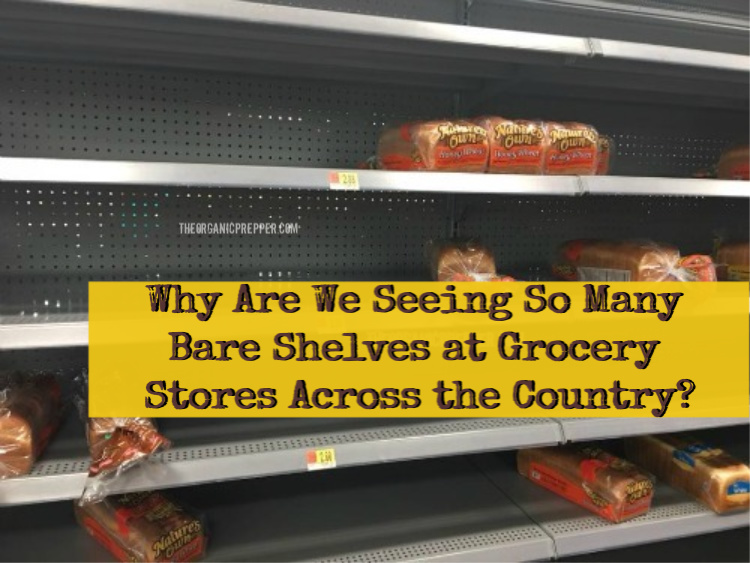








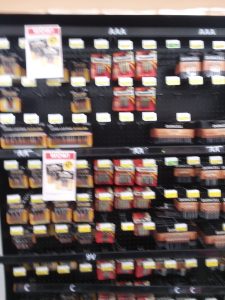
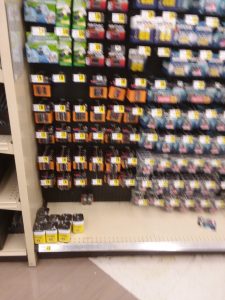

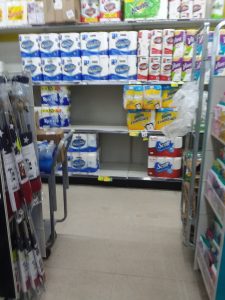

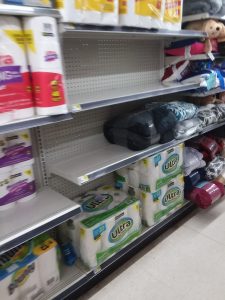







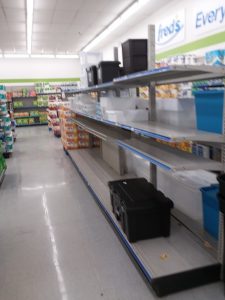
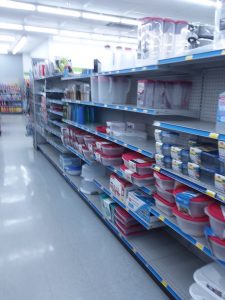

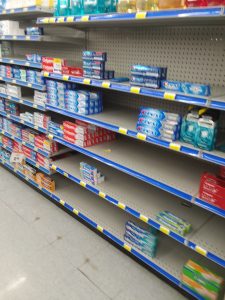
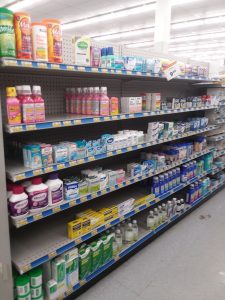
















67 Responses
You nailed it with the truck driving situation.
I am not seeing this in central virginia, but if we have a major supply line disruption, it’s gonna be a different story
“just in time” won’t serve us well in the end times.
EMP or CME, everyone’s toast…
Au contrare… I’ve been complaining to others about Kroger routinely being under stocked & now they are
pulling products or “downsizing” brands…seemingly going more toward Kroger name brands. Produce seemingly
always “waiting on the truck.” I’ve found it quite inconvenient. 🙁 Recently moved to GA and the same w/Kroger
and now Publix.
Keep in mind that each store has a “set” and might not carry everything the store on the other side of town carries, and the set changes, hence why you find something you like at the store one week, and never again a few weeks later. Sometimes something in an ad isn’t even carried by a particular store even though the ad is for that specific store chain.
Also, a server somewhere in the bowels of corporate does all the ordering, with some assist from the managers of each dept, produce orders the old fashioned way. With every sale noted by the server at corporate, it knows what we have on hand and how well something sells and some secret algo sends the order out and the truck gets filled with whatever the computer thinks people should have.
I posted just a bit ago (it hasn’t been approved yet as I type this) about a particular brand of milk where I shop often missing from the shelves (and it’s been missing for several days as of today). At the Kroger here in SW VA where i also go, however, even the variety of Kroger milk I get is sometimes out or, very often, nearly so. The last time I went to get some the other day they only had 4 in its entire case.
I live in the Pacific Northwest, Idaho but near Spokane. Completed our weekly shopping trip on Thurs., Jan 31
by going to all three of our local “big box” stores. Of the items you listed, we were unable to find only a type of toothpaste which my wife likes. There seemed to be an ample supply of literally everything you mention or show. Don’t know if this is the case over the line in Washington, but I haven’t heard any complaining. Not that I don;t expect things to turn, and quickly, in the event of any number of different events, false flags, etc., but for now it seems to be business as usual around here, which means most people are giving themselves colonoscopies………..
This article is spot on. What I’m seeing in my area is major chains “remodeling”. After the remodel full isles of things like pasta or baking goods are now just small sections with few choices. What was once a full aisle of assorted baking supplies is now a quarter aisle of mixes, a small section of staples like flour, sugar etc. Another small section of oils and a tine section of spices. Those shelves don’t look empty but it’s a lot easier to keep a 4 foot section of shelving looking stocked. Items in these sections frequently aren’t full all the way to the back of the shelf. There really is less stock and fewer choices. These are permanent changes to the store layout so this isn’t some temporary or short term outage. The explanation I was given when I inquired about the new change was that this particular store chain was doing away with the dedicated natural foods section and incorporating those products into the entire store. The problem with that is that there are very few natural products in each section and fewer items available overall.
I have no idea what this woman is talking about with the groceries. Here in the NW suburbs of Chicago, our stores are fully stocked and there are exactly ZERO shortages of anything.
I do agree the government, with the new regulations for truckers, has hurt them very badly and what they have done is inexcusable,
I live about 90 miles NW of Chicago and I HAVE seen this, at Walmart, as well as regional grocery chains. My husband has noticed it, too. We have several times gone to our regular stores and not been able to get something. Also, we’ve noticed only one or two items, when typically in the past there were several. Now that I think about it, I have many times in recent weeks asked myself if I should take the last one, or leave it for someone who might need it more. So that tells you something …
If you travel to the extreme southern part of Illinois, you will find all of the shortages the author mentioned and more.
I haven’t noticed any significant shortages in or around my suburb of Boston. Every so often the organic 2% milk is sold out or my favorite brand of bread isn’t in stock, but that’s about it. My family moved here from Iowa last summer and I will say that in Iowa the stores were better organized and stocked and most of the produce and meat were of much better quality.
I also have seen shelves in stores like this. They used to keep about 3 days supply of food on shelves at all times. Now it is only about 2 days and no back ups. Fresh Produce in most of our stores are not good. So have to go to different stores to find good produce like lettuce and tomatoes. Also I have been in stores where they have pushed back all the can goods, etc. As to why I don’t know. I thought at first they were getting ready to restock, but that would have put the newer items to the front with older items in back. Also I think inventory is playing a role. Stores have been cutting down on inventory as well. I am going to be watching much more closely at things going on in the stores I shop at.
Wow! Your store looks like Monday evening at the local WalMart. I live in a small town and keep up with the times the WM truck comes to town. Several times a week, but often not “full” loads. Bog truck comes very ear;y Monday morning, and I shop mid-morning. I do have to allow for the employees to stock the shelves.
We used to have a family rule of “if you open the last of a product, pit it on the shopping list”. For the past two years, the rule has been “if you open the next to the last…”.
Take a look at your stores’ floors. Rows of shelves are being removed. Old wax stains tell the truth. There is a newer WM in a nearby town, that has removed so many rows of shelves and cooling units, that I could drive my Dad’s large pickup truck thru most of the aisles at a fast speed. Local grocery stores are getting so empty.
I hear people say they will go shopping when an event happens. They can just forget that idea. Most of the stores already are almost empty.
I began noticing empty shelves back in 2012. My husband was a regional driver that serviced these big box stores. He was skeptical when I told him about the empty shelves, but a visit proved me right. He was amazed at how empty our local store was. We had already begun putting away a few items (due to weather related problems), but this really kicked us into preparedness. He totally agreed with the trucking issues brought up in this article.
Retail stores are changing to a “what sells here” strategy to compete with online retailers.
For the past 3 Years all Wal-Mart’s in our region (Wisconsin,Illinois,Minnesota) have removed items they do not sell enough of and stock items that turn over quickly. Stores do not make profits warehousing unsold and unwanted inventory. Especially considering we can have just about anything delivered to our doorstep.
I went to Walmart last night. NEVER again will I shop at night – there were a bunch of empty shelves. How is that possible? I’m seeing these empty shelves more and more frequently. Glad other people are paying attention too!
Compliments on a well-researched and informative article. I have been noticing the bare shelves but never realized the backgrounds.
We’re in nice medium size town not far outside of Oklahoma City. I usually go into the closer suburbs to shop. I have noticed a little of this over the last six months. However, it has really increased over the last couple of months. A couple of weeks ago I noticed the ice cream section had been reduced from probably six sections to maybe 4. A few days later I was back there and they had whole groups of rows completely gone in 3 parts of the store. Huge sections. I’m sure they’re rearranging but the weirdest thing is that I was back in the store yesterday and it was all still wide open. Nothing had even been done that I could tell.
Check the Baltic dry index. Was 1200 Jan 1 now 600’s. Cargo containers halved, which means the goods aren’t there.
I don’t know how true this was but awhile back I was talking to someone that worked in the procurement area of one of the big box stores. I had asked why I didn’t see any canned veggies other than beans, corn and peas. This is what I was told, corporate policy said it’s because shopping habits changed and people don’t buy cases of things like mixed veggies, beets, etc, (news to me and a few others). The person I spoke to (privately) told me it’s because the farms are not producing enough and are no longer willing to make steep cuts in their wholesale pricing to the “big” box stores. All I know is that over the last 10 years I see the shelves getting smaller and smaller, less goods on them AND real food like dried beans, rice etc are relegated to a VERY small areas on the shelf. While prepacked chemicalized microwave and canned meals are in abundance. Produce is, thankfully, still good around me as we have a quite a few small growers that still do a farmers market. DH will go to the store with me occasionally and doesn’t really see what I have been seeing. He sees “full shelves” and wonders what am I talking about.
I have been watching the empty shelves for the last 3 months I think there is amessage there for us to see. and that is expect to see more of it in the future. I live in south Fl. and no hurricanes forecasted
I learned about the trucking situation exactly as you describe it from when I worked analyzing mail for the Secretary at DOT. The bureaucracy and total lack of willing to actually do work is what made me leave government work after that. I also learned that most all bridges are well past their sell-by date so it gives me trepidation going across any of them. Also heard a lot about the Takata airbag and guard rail deaths…
It will be interesting to see how things change when driverless trucking starts being implemented. I’ve heard it could happen in the next 5 years. Even less motivation for someone to become a trucker… bet it happens quickly as more and more truckers jump ship to other careers. My brother just got a new car with “driver assist”… says he barely has to touch the wheel while driving now. And then there’s the whole Amazon/Whole Foods approach that’s coming where we won’t even be going to the stores for food, etc any more… it will all be delivered to us. Sooooo many people’s jobs are about to be displaced by technology, and that’s not even considering the effects of AI. It’s overwhelming to think of planning for these changes. I sometimes wonder if the best preparation is spiritual… and learning how to be flexible and adapt.
Stores like Whole foods and Jewel have been delivering food for awhile now around me. But in all honesty, I’d rather pick out my own produce, thank you very much. And yes, many jobs will soon be replaced by technology. Perhaps $15/hr x 24 hrs/day x 365 days a yr ( $131,400 ) is a bit much for just one stocker, janitor, or cashier around the clock. You can call me mean and insensitive, but if it was my business…..
Great article! I think a very large part of the problem is disruptive technology (a good thing), causing a major change in cultural and economic habit patterns. For example, I can deal with traffic, parking, and of course the obnoxious and overcrowded conditions at my local Walmart. Or, I can find my favorite pantry & personal items on Amazon and have them delivered free to my front door with the click of a mouse button. Heck, all of my favorite non-perishable items (and brands!) are databased on my various lists, and I can set up automatic delivery or order on demand to meet my needs. It is a waste of time and energy and fuel to go to the grocery store for routine items, not to mention you have to handle a product 6 times to get it home and in your fridge or pantry. Why bother, when the cost and convenience are vastly improved with online shopping. For my grocery store essentials, I drive past Walmart and go to Albertsons, a very customer friendly store. I custom order my frozen foods, meat & poultry (etc) by the case and take the products home and put in a freezer. Again, a huge savings in time and money and fuel.
Even furniture & appliance shopping is no different. The end result is the Big Box store is rapidly becoming obsolete as are many components of the “Just in case” logistics in grocery stores. Likewise, the truck delivery & shelf stocking is a decades old business model that isn’t going to be able to keep up with the speed and efficiency of an information based society. Which is to say and observe that Fed Ex and UPS type 1-2 day delivery systems are thriving, whereas big rig (18 wheel) trucks struggle with the grocery store model of rapid inventory turnover. The trucks are much more suited to long haul cargo. The answer to the grocery store lag is of course robotics and artificial intelligence, which is coming on line now. But it will be painful for the companies and business models that can’t keep up.
People that live paycheck to paycheck are pretty much stuck with the existing system, so they will experience the most pain as the grocery store shelves run dry and experience disruptions. Ditto for SNAP/welfare recipients who have to make purchases in discrete increments of what’s available on the shelf. At least until the system allows them to order products online with those benefits.
No doubt the food supply problems will continue to degrade! Civil unrest, food riots, crime, and so on will continue to increase which will drive up the cost of food production and distribution to pay for security. Historical cycles playing out again, just like in Venezuela.
I live in eastern Toronto (Canada) & we are seeing the same patterns here with shelves being empty. We recently had a heavy multi day snowstorm & a lot of gas stations ran out of product as they cudnt get their delivery tankers on the property. In some places gas prices soared 20 cents a litre almost overnight.
The most amazing thing I’ve seen recently is how fast a Wal-Mart can close. One day I noticed a larger than normal clearance section & went back a couple of days later to find almost every product on clearance. This one lacked a grocery section and the pharmacist said all staff were being absorbed into other nearby locations. So that is a huge store in a huge shopping centre that will now sit empty.
Very interesting read… I live in mid BC. Canada and over the past few months I’ve been telling my husband the exact same thing, up here north of the border. Last week the lack of wares on the shelves in the stores was exceptionally bad. I had to go to 3 different stores just to be able to get the basic items we needed. Milk and butter being the most difficult to find. Things that we commonly use such as Milk, butter, eggs, toilet paper, various canned and dried goods, bleach, bread etc. The list could go on forever. We have considered us “fortunate” that we have a Walmart in our small rural town, which has a mere population of approximately 15000, including those of us that live outside of city limits.
My monthly shopping runs start out at our local Walmart. I am however often forced to go to at least 2, sometimes 3 more stores (more expensive) if I want to be able to buy everything on my shopping list, even if I am quite a few times forced to buy the more expensive brands, due to that our regular brands are not in stock. We’ve also driven the 3 hour drive to a larger town/city that has a Costco but, won’t be doing that again, as it is the same situation both in their regular stores as well as Costco.
I’m up to speed on our preps but, really don’t want to start in on them… Planning a secondary prepping just to be able to deal with the everyday empty shelves shortages.
Many thanks for a wonderful and highly informational website!
//Solani
Yeah been seeing it alot at my Walmart in Western NY,I blamed it on just not enough help to fill shelves.the weather last few weeks were worst,no bread other than expensive special kinds of bread.my governor shut Thruway down and gave at 600 tickets or more to anyone that violated it last week,so it’s been bad.
Yes, I have seen a lot of remodeling in our stores as well.. the aisles are getting larger, shelves are smaller and the shelving units are placed in staggering portions in the middle of the store instead of closer to the outside walls. Very deceptive.
If you’re not a regular shopper you wouldn’t notice.
Here in the Upper Peninsula of Michigan I have noticed the short supply or no supply of large packages of toilet paper, certain kinds of chips, velveeta cheese including store brand, several items in frozen foods and a few other products I can’t think of off the top of my head. I was really wondering about this and whether I should start “prepping” more than I already have. Thanks for the info.I think I will step it up a bit.
Almost every comment has Walmart in it. This is also a problem we have put all our eggs in one basket so to speak and all the local stores have been put out of business by Walmart. I have noticed the gradual price increases at our local walmart and now shop at Publix because they are as cheap and sometimes cheaper. I think walmart thinks we don’t pay attention to this. Our local walmart is CONVENIENTLY out of all store brands during the Holidays so we have to buy the expensive name brand or go somewhere else.
No, I have not noticed any particular shortages, except when the sales are exceptional, maybe. But this is worrisome.
Having worked grocery off and on since 85, I’m familiar with its inner workings. The store I’m at now is in a town of 15k and we occasionally run out of items but seldom have the sweeping bare shelves as the pictures show. Matter of fact, corporate is trying to fill every space we have with something to sell, even taking place of carts out in the foyer. That being said, we can get cleaned out of bread and milk easily if the population is expecting bad weather or there’s a holiday or the national felon league has a bowl game.
As to the trucks, we get one almost every day (the norm is every other day) but they don’t carry the same things, sometimes it’s a produce and dairy run, other times its dry goods. A lot of items we carry are brought in and shelved by the vendors themselves; pop, chips, breads, floral, snack cakes by you know who, etc. There’s not enough room for more than one truck per day anyway in the back end, it all has to be stowed somewhere and of course the cold stuff has to be kept cold. The lack of drivers is apparent, even been seeing religion of piece drivers who apparently get around the state by a gps that speaks arabic.
The JIT model is and has been in use for some time, we don’t have the capacity to carry an inventory much greater than what is seen on the shelves. As a backwater store, we get what’s left after the bigger stores get serviced by the warehouse, if an item is low on hand at the warehouse, the bigger stores will get that item and we won’t see it till the warehouse gets more on hand, and of course the store takes the blame and corporate frowns on us when it wasn’t our fault.
When I get there, the back room is often so full you can’t get from one end of the back room to the other and have to come in to the store to get access to the far end due all the pallets. The day management shift spends most of its time stocking shelves (because corporate is too cheap to hire a day stock crew) and prepping the back room for the night stock crew. We also have to get rid of the pallets, egg, and milk crates and two dumpsters of waste every day and that all takes trucks, drivers, and store manpower.
Shame of it is I see tons of food go to waste. One time I saw a entire tube of cheese, one of those giant tubes they slice cheeses off of, unopened but out of date just laying there on top of the dumpster. The fried chikin and so on we can’t give away because someone decided to sue once and that stopped that practice however we do give produce and bread to charity. If I see someone rooting around in our dumpsters I let them be and have often helped them, we’re sposed to call the cops. And ohhh all those glorious pies just tossed into the dumpster! Steaks too.
Speaking of nite stock, sometimes shelves are bare because few want to work till 4am or even later for less than 9 an hour when Casey’s and dollar general down the street will start you at over 10.
Our store has a serious problem with turnover, not just in night stock, however most important turnover is night stock because without them we’d all be screwed.
Whoa~! Where is this place with such good stuff in the dumpster?
I began noticing limited amounts of products several years ago but now they have advanced to some empty shelves and only stocking high demand items. Fox example, there is plenty of all purpose flour but no bread flour; there is lots of small jar yeast, but no SAF or larger packages of yeast. I had to go to three stores to find liquid pectin and bought the two packages they had. No local stores stock glutton for baking, I have to order it online. Certain types of pasta are more difficult to find now; sporting goods shelves have only one or two items stocked, except at the start of hunting season.
Even the hardware stores only carry one sample of some items, if you want one it has to be ordered and it takes a week to get to you. If your appliance breaks, you have a hard time find what you want in stock at most stores.
I try to shop at family owned stores in my location; I pay a little more than I would at a company owned store but I feel better supporting my local community. If I can find a product made in the USA I will pay more for it rather than buy something made overseas. I will not knowingly buy any food products from China, India or Indonesia because they are contaminated. I lived in all of these countries and know that foreigners, rich people and politicians all order their food from USA or Europe because of poisons in the ground and air.
One of my sons was a long haul truck driver and he quit and went to local delivery trucking. He makes more money and is home nights and weekends with his family.
It is not just the truckers being held to so many hours on the road. A friend who was a major producer in growing livestock-cattle, chickens, vegetable produce, fruits for the consumers market. Could not put with the regulations any longer, apparently he is not the only producer here in the states that has called it quits. The gov regulations, prices they are allowed to set for market, so he said enough. That does not include all the paper work they had to fill out every year, on top of the inspections from the stuff shirts in suits.
patientmomma
Hello, it has been a while nice to see you are still posting.
It is so funny (not in a laughing way) that you wrote this article. I am one of those people that shops
the best sales between 3-4 different local stores. I have been mentioning to my husband that I cannot believe the amount of times I have seen empty shelves. It is usually a few items throughout the store, and not the sale items either. I have noticed it a lot with 2 stores in particular but, then again, they are the stores I frequent the most. Was wondering if anyone else had noticed it and am glad that I am not going crazy!
As always, great article Daisy!!
in illinois, its getting worse, in 2020 we get 15 dollar an hour wage law in steps, its crashing the US dollar value now, the shelves really do look like whats in these photos, and Walmart fired 25% of the staff so less people to pay, and put in self check out machines, people are just walking out of the store with free food, the policy is, if its in a bag they will not stop you, so they do.
STORES CUTTING BACK ON EMPLOYEES STOCKING SHELVES. VERY SLOW MOVING LAZY STOCKERS (WALMART).
Yes, we have a Wal-Mart supercenter here in Flippin, AR (small town), but over the last several years they have less and less. And for the past year it seems the bread section is very low. Thought it might be a problem getting fresh bread, but it’s been going on too long now.
Cheboygan, Michigan – near the Mackinaw City/Bridge. Walmart Super Center. I have never seen it so empty – especially in the fresh produce department. Entire rows of large black produce bins – EMPTY. Fresh produce was very scarce and this is just a “normal” week. Store employee told me that department managers are not allowed to place orders to restock shelves. All is done from central office and they only replace once the item has sold and out of stock. Something is very wrong here. Will keep watching.
I wonder how much of the problem is just ordering practice as well. One of the things the business schools have been preaching for years is to minimize the amount of inventory on hand. I saw this at a power company I worked for, where the activists shareholders wanted our working capital (so think piles of coal at the plant and oil in the tanks) reduced to levels reported by other companies (in $’s, which is hard because not all coal is the same). But the problem was, especially if you had long term supply contracts, that demand is weather dependent so if there was a warm winter you would end up with extra coal that year and it wouldn’t be until the contract expired that you could reduce purchases. Reselling the coal is impractical once it’s off the train and usually results in a loss even if it’s still on the train because everyone is overstocked after a warm winter. But if you take the alternate strategy of going into the winter short on coal and it is cold, you can run out before the winter is over and then the trains are not available to bring in new coal fast enough. Normally you build your pile of coal all summer long and then use it up over the winter, so the trains are sized for that sort of schedule and so are the mines. If this same sort of “working capital” reductions are being applied to grocery stores it could also explain the bare shelves. The problem could go all the way back to the distributors trying to minimize the number of pallets in the warehouse. You see this at Costco all the time where one week they will have a whole pallet of Kraft Dinner on the floor and another on the rack and the next week they have none. So since it has a really long shelf life and the boy and his friends eat it by the bucket when it is in stock I buy more than I need, which means Costco runs out faster but I have lots at home. And then when it comes in stock again I buy more than I need again even if I still have some at home. I do this because we did actually run out of KD once and it turns out that is a bad thing when the boy has his friends over for a video game and Nerf gun day. I’m not feeding them steak. They get KD with hot dogs and ketchup, and it is in fact their preferred meal.
So you can see, what the stores are trying to do by using modern working capital theory is force you to carry the inventory at your own expense on your own property. If you have a large pantry and a cold room that isn’t too big of a deal these days if you have the money because the bank doesn’t pay any interest, so you may as well have cartons of KD in the cold room. But for people who live paycheck to paycheck this is a problem. Guys like me are front running them and literally buying 3 cartons of KD at a time when it’s there and putting it in storage.
I see this also at the local Co-Op, where we buy things Costco doesn’t carry or if we just need milk so I don’t want to drive to the Costco. They will from time to time get a pallet of KD and put it on sale for prices similar to what Costco charges, but once the pallet goes down they take the boxes out of the cartons and put the boxes on sale at about twice the price. Or another interesting item is these breakfast chicken sausages my boy loves. The shelf is usually empty, but about 1/4 of the time there are some sitting there so I take them all because we have a freezer. So they are again using my interest free cash and my already existing storage facilities to push the “working capital” from them onto me. But why not? I don’t get paid to keep the money in the bank and the boy eats up the sausages in no time.
So I don’t really believe there is a supply crisis or a shortage of drivers. The market would address all of that through prices, even if regulations were adding to those prices, which they always do. Instead I think it’s modern economic “working capital” theory at play. Corporations are transferring the cost to carry inventory from there own balance sheets to ours. Since they have to pay interest and we don’t get paid interest, this makes sense. Why have $8 dollars sitting in your bank doing nothing when you could have a carton of KD in the pantry instead? At least that way if it snows you can eat without having to dig out your car. So don’t bemoan the situation, stock up when it’s there. Apparently you should have a month’s worth of food anyway. Of course that only works if you have some cash, so there are many people who are screwed either way.
Do you think the rise of Amazon & Amazon Pantry (and all other Big Box retailer have instituted delivery programs) have anything to do with these shortages? That perhaps they are keeping the stock at the warehouse longer for potential internet orders etc.
And since everyone is into this internet shopping, perhaps stores are not so eager to fill shelves just to let product sit?
My neighbor’s office is next to a pet food store & she still buys from Chewy.com. This shift in consumer buying habits has to have some impact on the supply chain.
This is a pleasant thought, however after experiencing the quality of produce that will be delivered to your door I have to think you would never want someone else to pick your produce or meat for you again.
Why so many bare shelves we ask ? The answer of course is -we are all being conditioned into eccepting the new normal, things being in short supply, scarce.Well get used to it because it will get much worse.
Art, Aust.
Agree 100%.
I shop at Walmart.com because I cannot carry a lot of grocery bags anymore. Walmart is even out of stock with the online foods. I cannot get the same ORDINARY foods or supplies month after month. And another curious thing has happened with shipping containers, also known as Conex containers. I live inland, not near any major port. If you wanted a shipping container in the past, you had to go to Miami, Florida, and have it trucked back home. Just in the last 6 months, there are several people in our area selling shipping containers on the Online Yard Sale groups. Why so many not in use?
Here in western NC, my local Wal-Mart supercenter has bare shelves. When I first moved here over ten years ago, people would be stocking shelves throughout the day. There was hardly ever any empty spots and, when there was one, it was due to the warehouse being out of that product. Now, it’s rare to even see someone stocking and the shelves constantly look like a major snow storm is coming. Sometimes I have to go to two or three other local grocery stores just to find what I need or, as a last resort, order it on the internet.
The first part of the article seems to point to something sinister causing certain product disruptions, and it is not. The reasons you list later in the article are, indeed, causes, if not singular then in total, as to why some products are in short supply or absent on store shelves.
Its not surprising that the big box stores are now selling more “prepper-related” products. Prepping has come out of the shadows and is now common practice among a growing segment of the population. Retailers are trying to get a share of that market and I am happy they are.
As well, just in time inventory practices, in use for years, certainly have a lag time to catch up to changing customer demands.
I wouldn’t be too concerned about this. Retailers want to make a profit, even though grocery stores exist on a very thin line of only about 2%.
I am not seeing this along the NY/NJ border in our local grocery stores. I haven’t been to Wal-Mart since last summer but that was well-stocked. It doesn’t mean it can’t happen as we learned the hard way with Hurricane Sandy!
Great article! My mother always said that “just in time” delivery would bite us in the butt, and it has. I have noticed empty shelves here (Sacramento County) at Walmart, grocery stores, and even the big box places. Of course, don’t ask for anything, because nobody has storage in the back, and no one knows when/if certain things will ever show up again. I had a friend staying with me, who likes Mocha Mix for her coffee. Walmart didn’t have it, they could not even order it, etc. It took me perusing 3 grocery stores to find it-at a 25% mark up. Now, 8 weeks later, Walmart has it back on the shelves. (????) My girlfriend and her husband are long haul truckers. It is hard work and the government regulations are killing the trucking industry. Some of the companies are offering $10,000 signing bonuses, and still no takers. Government interference is going to murder this country!
I am making my prepper lists in terms of buying cases. Incidentally, notice the price of canned hams lately? Yeah…….lots of people wanting them as they last a long time but are basically a fresh product when opened. What used to be $10-15 is now $18-20. I hope that all of us are stocking up as much as possible because I don’t see things improving.
PS_Thank you for mentioning pet foods. I have 2 cockers and still try to keep 8 25 pound bags of kibble at all times. Dogs can do well on a home cooked diet of meat, rice, and vegetables. However, you may not have time or facilities when SHTF at first. So a gradual transition would be best for both you and dogs. If you are a cat person, most tabbies do well on rice with canned sardines-but again, it is a gradual transition. Bird people-stack that seed high!
Here in Kansas I haven’t noticed any shortages or empty shelves at any of the stores, even Walmart.
Something to keep in mind is the dhs and martialawmart agreement. Wally world and dhs made some pact where martialawmart will become the goto source for the US Army in domestic operations as martialawmart has the infrastructure in place to assist the department of homeland subjugation in martial law. This was in the news some time ago. I have to assume it’s a partnership between martialawmart, fema, dhs, and whoever else participates in the subjugation of the USA.
I live in NE Ohio, and I have to say that I’ve noticed empty shelves at the big box stores and some smaller grocers.
I don’t think it’s the end of the world, but if something I’m looking for is out for weeks, I’m stockpiling from another area that has plenty.
Unfortunately, since I am unable to leave my home, since it is broken into even if I walk around the block, I have not scene this, however, I have my groceries delivered and when I place an order, the store is often out of common items, which they do recieve later in the week and deliver.
Maybe I should move to Venezuela! Their shelves are full, as you can see, reported in The Saker, but I don’t speak spanish.
http://thesaker.is/reporters-diary-from-venezuela/
The issue is not that there is absolutely no food in Venezuela. It’s that a bag of rice costs an entire week’s salary.
Two weeks ago on an early Saturday morning, I was at Aldis. There were many items not in stock and the shoppers were mad and going off on the employees. I’m in Kentucky.
My father’s heart medicine is on back order. He is in Colorado Springs.
Regarding my father’s medicine, my mother said there is a nationwide shortage from the manufacturing company.
Went shopping again today with fresh eyes on this situation. I’ve been noticing this for a while and now I’m starting to make note of the things that are missing. These will be the things I’m going to work on stocking more of whenever I find them at a decent price. Today I added clothesline to my list. Of all the crazy things to be out of! But it’s true. I’ve been to six different stores and finally picked up the last clothes line left on the shelf in the 6th store. I’ll be stepping up my stock of rice, beans and trash bags. Powdered milk was missing in two of the 6 stores I went to. We’re talking basic Prepper 101 stuff.
The shelves look very similar in our area (Central Texas), almost identical items are often empty. I agree with the reasons listed above and they are real issues. I also think another reason not stated, is sales and couponers. I know for myself with a lot of the items shown to be missing, when they are in stock, and on sale, I buy in bulk. I know around here there are a lot of couponers, these women will buy out whatever stocks they have, for super cheap or free and resale on facebook or garage sales, for a lot of them it’s a home business, tax free.
Good article but I have to disagree with this: “There are a lot of factors that will need to be addressed to prevent this from getting worse.” Imo there is only one factor. It’s called freedom.
About the time this article was published, I was looking for everyday table salt. None of the groceries had any. Not at the dollar stores either. I mean Walmart was out too. Big gaps oN the shelves. I couldn’t get a straight answer when salt would be back in stock. I let my fingers walk to amazon ordering what I needed. A few weeks later the shelves were stocked again with salt although the slots are now smaller and I see where the stock is not nearly full. I live in Indianapolis so it’s not a tiny town.
Thanks Samatha — I followed you here from Backdoor.
I am in the five college area of Massachusetts. The two Target stores grocery area are repeatedly missing entire sections of fresh produce, meats, juice, eggs. I work for a grocery delivery company (app based). One day I asked an employee if the had any chicken in the back stock/warehouse area. He told me, “Yes. Its sitting on a pallet in the back”. Due to some food safety government regulations it could only be put out by a “qualified” person! Other times they are just wiped out of berries, banannas, bottled drinks of certain kinds. Another thing I have noticed is that whatever the customers order through the app just doesn’t match real time with the store’s inventory. Very frustrating. Starting to feel like Cuba or something.
here in springfield illinois its been going like this for over 1 year now, and old, and i mean very old fruit on the shelves, i tell my local friends and they dont seem to notice or even understand what i am talking about, they simply dont pay attention, these photos are now normal in my city, i do know the Walmart that now has 90% self check out, people are just bagging it and not paying for it and walking out the store. the policy is, if it is NOT in a bag, then they will stop you and ask you for the proof you paid for it, just 1 store lost 1 and half million dollars in loss from the self check out machines, and its just getting started, we get new 15 dollar an hour minimum wage law in 2020 in steps, its crashing the dollar value 8 months ago when the law was passed.
I know this is an older article (I found it through the new article on what Iran means for prepping), but now that I think about it systematically, I’ve noticed similar shortages on shelves in my own area (southwest Virginia). Most recently there have been empty shelving showing up when it comes to milk. In fact as I write this, one particular brand has only had an empty shelf for the last few days.
Up until recently our rural area in west Michigan hasn’t seen much in the way of bare shelves. This past weekend was horrible. 2-12-22 The Wal Mart had huge bare spots, even the milk was low which it never is on the day I was there. Now the regional chain store in the same town was better supplied but low on some things as well. I’m guessing they were getting all the people would couldn’t find what they needed at WM. Until a few years ago WM and a small local grocery were the only places to shop locally.
There has been no weather events that would account for the unusual bare spots